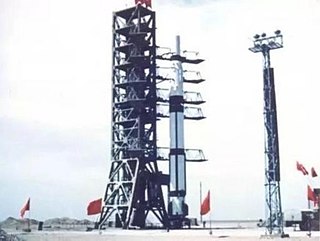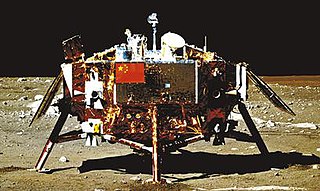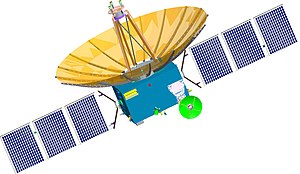
The space program of the People's Republic of China is about the activities in outer space conducted and directed by the People's Republic of China. The roots of the Chinese space program trace back to the 1950s, when, with the help of the newly allied Soviet Union, China began development of its first ballistic missile and rocket programs in response to the perceived American threats. Driven by the successes of Soviet Sputnik 1 and American Explorer 1 satellite launches in 1957 and 1958 respectively, China would launch its first satellite, Dong Fang Hong 1 in April 1970 aboard a Long March 1 rocket, making it the fifth nation to place a satellite in orbit.

Chang'e 1 was an uncrewed Chinese lunar-orbiting spacecraft, part of the first phase of the Chinese Lunar Exploration Program. The spacecraft was named after the Chinese Moon goddess, Chang'e.

The Xichang Satellite Launch Center (XSLC), also known as the Xichang Space Center, is a spaceport in China. It is located in Zeyuan Town (泽远镇), approximately 64 kilometers (40 mi) northwest of Xichang, Liangshan Yi Autonomous Prefecture in Sichuan.

The Chinese Lunar Exploration Program, also known as the Chang'e Project after the Chinese Moon goddess Chang'e, is an ongoing series of robotic Moon missions by the China National Space Administration (CNSA).

The following outline is provided as an overview of and topical guide to space exploration.

Chang'e 2 is a Chinese uncrewed lunar probe that was launched on 1 October 2010. It was a follow-up to the Chang'e 1 lunar probe, which was launched in 2007. Chang'e 2 was part of the first phase of the Chinese Lunar Exploration Program, and conducted research from a 100-km-high lunar orbit in preparation for the December 2013 soft landing by the Chang'e 3 lander and rover. Chang'e 2 was similar in design to Chang'e 1, although it featured some technical improvements, including a more advanced onboard camera. Like its predecessor, the probe was named after Chang'e, an ancient Chinese moon goddess.

Chang'e 3 is a robotic lunar exploration mission operated by the China National Space Administration (CNSA), incorporating a robotic lander and China's first lunar rover. It was launched in December 2013 as part of the second phase of the Chinese Lunar Exploration Program. The mission's chief commander was Ma Xingrui.

The Chinese Deep Space Network (CDSN) is a network of large antennas and communication facilities that are used for radio astronomy, radar observations, and spacecraft missions of China. The CDSN is managed by the China Satellite Launch and Tracking Control Center General (CLTC) of the People's Liberation Army Strategic Support Force Space Systems Department.

Chang'e 4 is a robotic spacecraft mission in the Chinese Lunar Exploration Program of the CNSA. It made a soft landing on the far side of the Moon, the first spacecraft to do so, on 3 January 2019.

Chang'e 6 was the sixth robotic lunar exploration mission by the China National Space Administration (CNSA) and the second CNSA lunar sample-return mission. Like its predecessors in the Chinese Lunar Exploration Program, the spacecraft is named after the Chinese moon goddess Chang'e. It was humanity's first lunar mission to retrieve samples from the far side of the Moon, as all previous collective sample-return missions were done from the near side.
Manfred Memorial Moon Mission (4M) was the first private lunar probe to successfully fly by the Moon. It was led by LuxSpace, a child company of German OHB System, and named in honor of OHB Systems founder, Manfred Fuchs, who died in 2014. It was launched with the Chinese Chang'e 5-T1 test spacecraft on 23 October 2014. The lunar flyby took place on 28 October 2014, after which the spacecraft entered elliptical Earth orbit and continued transmission until 11 November 2014, exceeding its designed lifetime by four times.
The following outline is provided as an overview of and topical guide to the Moon:

The year 2024 is expected to exceed 2023's 223 orbital launches. So far, the year saw the successful first launch of Vulcan Centaur, Gravity-1, Ariane 6, and notably more developmental launches of SpaceX's Starship. Additionally, the final launch of a Delta family rocket occurred in April with a Delta IV Heavy. In May, China launched the Chang'e 6, the first sample return from the far side of the Moon. The Polaris Dawn mission conducted the first ever commercial spacewalk in September.

Queqiao relay satellite (Chinese: 鹊桥号中继卫星; pinyin: Quèqiáo hào zhōngjì wèixīng; lit. 'Magpie Bridge relay satellite'), is the first of the pair of communications relay and radio astronomy satellites for the Chinese Lunar Exploration Program. The China National Space Administration (CNSA) launched the Queqiao relay satellite on 20 May 2018 to a halo orbit around the Earth–Moon L2 Lagrangian point Queqiao is the first ever communication relay and radio astronomy satellite at this location.
Tianlian also known as CTDRS, is a Chinese data relay communication satellite constellation. The constellation serves to relay data from ground stations to spacecraft and rockets, most significantly China's crewed spaceflight program. The system currently consists of seven satellites in two generations, with the first satellite being launched in 2008.
Tiandu satellites are a pair of Chinese Lunar Exploration Program's lunar navigation and communications test satellites based on Queqiao-2 relay satellite technology.

ICUBE-Q or ICUBE-QAMAR is a Pakistani lunar remote sensing observation nanosatellite and is one of the four international payloads of the Chang'e 6 lunar sample-return mission. It is a joint venture between the Institute of Space Technology (IST), Space & Upper Atmosphere Research Commission (SUPARCO) and the Intelligent Satellite Technology Center of Shanghai Jiao Tong University (SJTU), under the framework of Asia-Pacific Space Cooperation Organization (APSCO). It is the first deep space mission of Pakistan.















